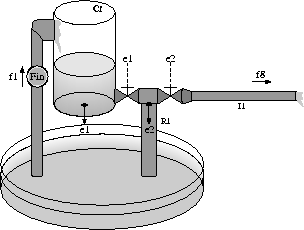Discontinuous effects in physical system models occur when energy
or power variables cross a certain threshold value. For example,
a diode is modeled to come on when the voltage drop across it
exceeds 0.6V. These discontinuous effects establish or break
energetic connections in the model, and this may cause
related signals to change discontinuously.
The tank system,
Fig. 2, has two pressure valves that open when either
pressure ![]() or
or ![]() crosses a pre-set threshold value. If the
specified threshold value for the valve controlled by
crosses a pre-set threshold value. If the
specified threshold value for the valve controlled by ![]() is
is ![]() the threshold value of the second valve, the opening of the first valve
will cause the second to open. If the resistance, capacity, and flow
inertia of the connecting pipe are abstracted out of the model, these
two discrete changes occur instantaneously and the mode where only the
valve controlled by
the threshold value of the second valve, the opening of the first valve
will cause the second to open. If the resistance, capacity, and flow
inertia of the connecting pipe are abstracted out of the model, these
two discrete changes occur instantaneously and the mode where only the
valve controlled by ![]() is open occurs for a brief instant in
time (according to the modeling assumptions it is instantaneous).
Therefore,
discontinuous changes may cause other signal value changes which result in
a sequence of discontinuous changes. Since modeling assumptions
require that discontinuous changes occur instantaneously, these
transitions are called mythical.
is open occurs for a brief instant in
time (according to the modeling assumptions it is instantaneous).
Therefore,
discontinuous changes may cause other signal value changes which result in
a sequence of discontinuous changes. Since modeling assumptions
require that discontinuous changes occur instantaneously, these
transitions are called mythical.

Figure 2: Tank with two pressure controlled valves.
In this paper we establish that state variables in the system do
not change during mythical changes. The system does
undergo discrete state changes, determined by the finite state automata
associated with the controlled junctions.
Eventually, a sequence of discrete switches terminates in a real mode
(system behavior again evolves as a function of time), and
the continuous state vector for this new mode has to
be derived. This is illustrated in Fig. 3. Mythical modes are
depicted in a white background and real modes in a dark background. In
real mode ![]() a signal value crosses a threshold at time
a signal value crosses a threshold at time ![]() , which
causes a discontinuous change to model configuration
, which
causes a discontinuous change to model configuration ![]() , represented by
the discrete state vector
, represented by
the discrete state vector ![]() .
The power variable values
.
The power variable values ![]() in this new configuration are
calculated from the original energy distribution
in this new configuration are
calculated from the original energy distribution ![]() values.
If the new values cause another
instantaneous mode change, a new mode
values.
If the new values cause another
instantaneous mode change, a new mode ![]() is reached, where
the new power variables values, (
is reached, where
the new power variables values, ( ![]() ,
, ![]() ), are calculated from
the original
energy distribution
), are calculated from
the original
energy distribution ![]() . Further mythical mode changes may
occur till a real mode,
. Further mythical mode changes may
occur till a real mode, ![]() , is reached. The final step involves mapping
the energy distribution, or continuous state variable values, of the
departed real mode to the new real mode.
This issue is non-trivial, and discussed in detail in a later section.
Real time continuous simulation resumes at
, is reached. The final step involves mapping
the energy distribution, or continuous state variable values, of the
departed real mode to the new real mode.
This issue is non-trivial, and discussed in detail in a later section.
Real time continuous simulation resumes at ![]() so system
behavior in real time implies mode
so system
behavior in real time implies mode ![]() follows
follows ![]() .
The formal Mythical Mode Algorithm (MMA) is outlined below.
.
The formal Mythical Mode Algorithm (MMA) is outlined below.

Figure 3: State Evolution: Mythical + Real Modes.
A complete simulation system that incorporates continuous simulation and the MMA algorithm been implemented and tested on a number of physical system examples[9].